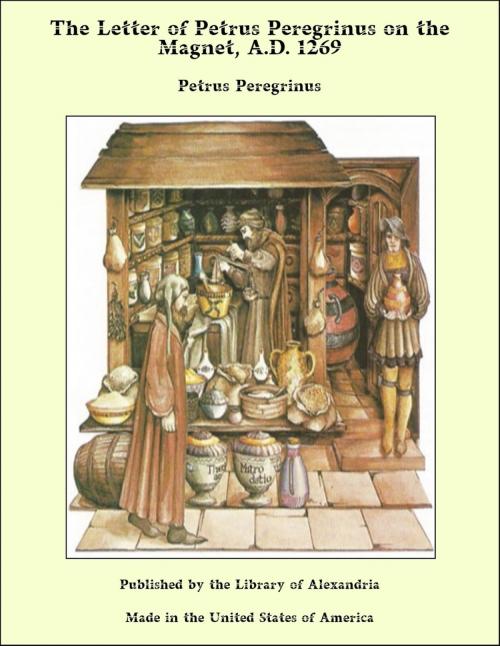The Letter of Petrus Peregrinus on the Magnet, A.D. 1269
Nonfiction, Religion & Spirituality, New Age, History, Fiction & Literature| Author: | Petrus Peregrinus | ISBN: | 9781465606181 |
| Publisher: | Library of Alexandria | Publication: | March 8, 2015 |
| Imprint: | Language: | English |
| Author: | Petrus Peregrinus |
| ISBN: | 9781465606181 |
| Publisher: | Library of Alexandria |
| Publication: | March 8, 2015 |
| Imprint: | |
| Language: | English |
The poet Claudian (365-408 A. D.) wrote a short idyll on the attractive virtue of the lodestone and its symbolism; St. Augustine (354-430), in his work De Civitate Dei, records the fact that a lodestone, held under a silver plate, draws after it a scrap of iron lying on the plate. Abbot Neckam, the Augustinian (1157-1217), distinguishes between the properties of the two ends of the lodestone, and gives in his De Utensilibus, what is perhaps the earliest reference to the mariner’s compass that we have. Albertus Magnus, the Dominican (1193-1280), in his treatise, De Mineralibus, enumerates different kinds of natural magnets and states some of the properties commonly attributed to them; the minstrel, Guyot de Provins, in a famous satirical poem, written about 1208, refers to the directive quality of the lodestone and its use in navigation, as do also Cardinal de Vitry in his Historia Orientalis(1215-1220); Brunetto Latini, poet, orator and philosopher, in his Trésor des Sciences, a veritable library, written in Paris in 1260; Raymond Lully, the Enlightened Doctor, in his treatise, De Contemplatione, begun in 1272, and Guido Guinicelli, the poet-priest of Bologna, who died in 1276. The authors of these learned works were too busy with the pen to find time to devote to the close and prolonged study of natural phenomena necessary for fruitful discovery, and so had to content themselves with recording and discussing in their tomes the scientific knowledge of their age without making any notable additions to it. But this was not the case with such contemporaries of theirs as Roger Bacon, the Franciscan, and his Gallic friend, Pierre de Maricourt, commonly called Petrus Peregrinus, the subject of the present notice, a man of academic culture and of a practical rather than speculative turn of mind. Of the early years of Peregrinus nothing is known save that he studied probably at the University of Paris, and that he graduated with the highest scholastic honors. He owes his surname to the village of Maricourt, in Picardy, and the appellation Peregrinus, or Pilgrim, to his having visited the Holy Land as a member of one of the crusading expeditions of the time. In 1269 we find him in the engineering corps of the French army then besieging Lucera, in Southern Italy, which had revolted from the authority of its French master, Charles of Anjou. To Peregrinus was assigned the work of fortifying the camp and laying mines as well as of constructing engines for projecting stones and fire-balls into the beleaguered city. It was in the midst of such warlike preoccupations that the idea seems to have occurred to him of devising a piece of mechanism to keep the astronomical sphere of Archimedes in uniform rotation for a definite time. In the course of his work over the new motor, Peregrinus was gradually led to consider the more fascinating problem of perpetual motion itself with the result that he showed, at least diagrammatically, and to his own evident satisfaction, how a wheel might be driven round forever by the power of magnetic attraction.
The poet Claudian (365-408 A. D.) wrote a short idyll on the attractive virtue of the lodestone and its symbolism; St. Augustine (354-430), in his work De Civitate Dei, records the fact that a lodestone, held under a silver plate, draws after it a scrap of iron lying on the plate. Abbot Neckam, the Augustinian (1157-1217), distinguishes between the properties of the two ends of the lodestone, and gives in his De Utensilibus, what is perhaps the earliest reference to the mariner’s compass that we have. Albertus Magnus, the Dominican (1193-1280), in his treatise, De Mineralibus, enumerates different kinds of natural magnets and states some of the properties commonly attributed to them; the minstrel, Guyot de Provins, in a famous satirical poem, written about 1208, refers to the directive quality of the lodestone and its use in navigation, as do also Cardinal de Vitry in his Historia Orientalis(1215-1220); Brunetto Latini, poet, orator and philosopher, in his Trésor des Sciences, a veritable library, written in Paris in 1260; Raymond Lully, the Enlightened Doctor, in his treatise, De Contemplatione, begun in 1272, and Guido Guinicelli, the poet-priest of Bologna, who died in 1276. The authors of these learned works were too busy with the pen to find time to devote to the close and prolonged study of natural phenomena necessary for fruitful discovery, and so had to content themselves with recording and discussing in their tomes the scientific knowledge of their age without making any notable additions to it. But this was not the case with such contemporaries of theirs as Roger Bacon, the Franciscan, and his Gallic friend, Pierre de Maricourt, commonly called Petrus Peregrinus, the subject of the present notice, a man of academic culture and of a practical rather than speculative turn of mind. Of the early years of Peregrinus nothing is known save that he studied probably at the University of Paris, and that he graduated with the highest scholastic honors. He owes his surname to the village of Maricourt, in Picardy, and the appellation Peregrinus, or Pilgrim, to his having visited the Holy Land as a member of one of the crusading expeditions of the time. In 1269 we find him in the engineering corps of the French army then besieging Lucera, in Southern Italy, which had revolted from the authority of its French master, Charles of Anjou. To Peregrinus was assigned the work of fortifying the camp and laying mines as well as of constructing engines for projecting stones and fire-balls into the beleaguered city. It was in the midst of such warlike preoccupations that the idea seems to have occurred to him of devising a piece of mechanism to keep the astronomical sphere of Archimedes in uniform rotation for a definite time. In the course of his work over the new motor, Peregrinus was gradually led to consider the more fascinating problem of perpetual motion itself with the result that he showed, at least diagrammatically, and to his own evident satisfaction, how a wheel might be driven round forever by the power of magnetic attraction.















